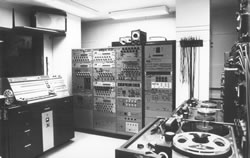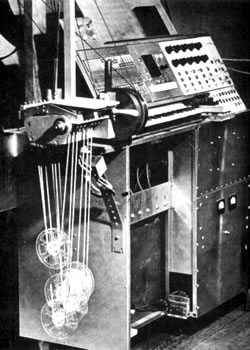Composing with Hugh Le Caine’s Fabulous Inventions in the University of Toronto’s Studio C, circa 1969
Closing the 2014 Toronto International Electroacoustic Symposium (TIES) was the Special Session “A Noisome Pestilence: An afternoon of Hugh Le Caine,” which brought together composers and researchers around Le Caine’s instruments. The session was moderated by Gayle Young on Sunday, 17 August 2014, and featured presentations by Kevin Austin, Richard Henninger, David Jaeger, Pauline Oliveros and Paul Pedersen.
In the early 1960s, tucked deep in the lower reaches of the Faculty of Music’s newly built Edward Johnson Building, was the new home of the University of Toronto’s Electronic Music Studio (UTEMS). Behind its windowless entrance door was a network of bare white cinderblock walled rooms of sundry sizes. The first was an office housing a small library and tape archive. Off to its left was a technician’s glassed-in lair with its workbench overcrowded by soldering irons, scopes, meters and miscellaneous electronic parts overflowing a myriad of drawers and shelves. To the right of the office was a small vestibule that in turn led to Studio “A” on its left. Studio A held UTEMS’ original equipment (Fig. 1) and was where the graduate classes in Electronic Music were given. Facing the hall was a smaller room that housed a large sheet-reverb unit and various idled devices. On its right was Studio “C”, which was reserved for larger projects by established composers. It held the latest inventions from Hugh Le Caine.

When I arrived as a graduate student in the fall of 1967, Lowell Cross was the occupant of the technician’s lair. This was barely a year after the famous 1966 summer class attended by Pauline Oliveros and R. Murray Schafer 1[1. For more on this, see Pauline Oliveros’ presentation in the Special Session on Hugh Le Caine at TIES 2014, “Participle Dangling in Honor of Gertrude Stein”, also included in this issue, as well as her Keynote presentation from TIES 2014, “What Matters? Make the Music!,” published in eContact! 17.3.], and just before Cross went on to Mills College. My class, which was much smaller than theirs, included John Rea (now of McGill) and John Rimmer of New Zealand. Gustav Ciamaga played us the latest electronic compositions from studios around the world even as he taught us the theory and craft of tape-based composition along with the mysterious ways of sound generators and signal processors. Razor blades and splicing blocks were the rule. Although classes were held in Studio A, we could see across to Studio C, where some of Toronto’s top composers like Norma Beecroft and Harry Freedman as well as visitors like Douglas Lilburn of New Zealand were working away on their latest creations.
I couldn’t believe my good fortune when, in the following year, along with my appointment to the Faculty of Music, Ciamaga gave me my own key to the studio so I could work there on my own whenever it was available. That included access to Studio C. I resolved to make frequent use of that privilege.

That year Dave McKenzie was the new occupant of the technician’s lair. Sporting a white lab coat, a mischievous smile, hyper-curly blond, unruly hair and a low, booming voice, he seemed every bit the mad scientist. He was perfect in the role of custodian for these cutting edge audio electronics. When I met him, he was adapting gifts from Le Caine to the tidy racks of Studio C, the heart of UTEMS. He became my guide to the inner workings of Studio C’s many audio playthings.
The studio’s four panels of racks stood about six feet tall and occupied its innermost wall. They held several of Le Caine’s Serial Sound Structure Generators (SSSG), which could be chained sequentially to trigger oscillators, modulators and filters. Flanking the racks on the left was a recent model of Le Caine’s Multi-track tape player. On the panels’ right was a pair of 2-track ¼" Ampex tape recorders and a recent model 4-track ½" Ampex tape recorder (Fig. 2). All this was audible via four Acoustic Research loudspeakers, each placed in a corner of the rectangular room. They produced glorious 4-channel surround sound.
As I became familiar with Studio C’s audio toys, certain of Le Caine’s contributions became my “go to” tools for creating the sounds I was beginning to imagine. However, I suspect that I came to use Le Caine’s devices a little differently than he had originally intended.

At first, I thought that the SSSG’s, with their dodecaphonic bias as intended by Le Caine, would suit my instrumental compositional habits that I had acquired while studying with John Weinzweig. One programmed the SSSG’s pitch classes, octaves, durations and amplitudes via thirteen dials for each to values that could then be retrograded and inverted at will. But I came to think of them more as a sound source by ganging them together in repeating cycles at very fast tempi. This made them sound more like an ordered version of a random noise sample and hold circuit.
Another fruitful use of the SSSG’s was to record the outputs from oscillators driven by them onto tape loops for consumption by the neighbouring Multi-track. This had a mixer for blending the timbres coming from its multiple playback heads and a keyboard for playing the resulting loops as a chromatic instrument by precisely varying the playback speed of the loops (Fig. 3). As I became more sound-oriented than note-oriented after working in the studio for a while, I began to rely more on the continuous pitch slider (glide strip) behind the chromatic keyboard than on the keyboard itself. This gave me swoops, wobbles and microtones that were much more interesting to me.
Another device that was invaluable to my changing needs in the studio was Le Caine’s capacitance keyboard, varyingly referred to as the Printed Circuit Keyboard or the Conductive Keyboard. Apparently there were several design iterations for his flat, touch-based keyboards. The one I used at UTEMS was quite small and compact, with two rows of evenly spaced squares (around 12 per row, as I recall) and tuning knobs. 2[2. This version was completely flat and didn’t go up at the back like the 1967 model shown on the Le Caine website.] It was a low-lying table-top unit that we usually put on the top of a wheeled platform so that its output could be patched to various voltage control inputs on the main wall of sound-producing devices.
As it turned out, Ciamaga and I had wildly different conductivity in our fingers, so the device as originally designed didn’t work reliably for either of us. McKenzie, ever resourceful, modified Le Caine’s creation with a rheostat marked with both a “Gustav” setting and a “Richard” setting. Once it worked properly, it became my favourite keyboard — I really loved the thing for its freedom from diatonic structures. The evenly spaced pads no longer attempted to mimic a piano keyboard. You could determine the pitch of each pad, tuning them to almost anything, and then zip around the surface with your finger, gliding effortlessly from sound to sound. All kinds of cool gestures could be performed on the instrument to produce glissandos, arpeggios and sound bursts, which at that time were impossible to achieve any other way.
My working methodology evolved into accumulating musical sound gestures made from various configurations and combinations of Le Caine’s devices into sequences that I captured on the smaller Ampexes using classic tape studio splicing techniques. Ultimately, these were transferred to the large Ampex where I could accumulate up to four layers of these gestures. Once completed, I would mix those four layers down to a two-channel stereo final take that became the composition. My work Reflections from Outer Space is a twenty-minute work in five movements (Audio 1) that offers a grand tour of the many sounds and ways of working that Hugh Le Caine’s inventions made possible.
Thank you, Hugh!
Social top